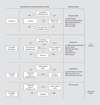Towards conceptualizing a neural systems-based anatomy of attention-deficit/hyperactivity disorder
- PMID: 19372685
- PMCID: PMC3777416
- DOI: 10.1159/000207492
Towards conceptualizing a neural systems-based anatomy of attention-deficit/hyperactivity disorder
Abstract
Convergent data from neuroimaging, neuropsychological, genetic and neurochemical studies in attention-deficit/hyperactivity disorder (ADHD) have implicated dysfunction of the dorsolateral prefrontal cortex (DLPFC) and dorsal anterior cingulate cortex (dACC), which form the cortical arm of the frontostriatal network supporting executive functions. Furthermore, besides the DLPFC and dACC, structural and functional imaging studies have shown abnormalities in key brain regions within distributed cortical networks supporting attention. The conceptualization of neural systems biology in ADHD aims at the understanding of what organizing principles have been altered during development within the brain of a person with ADHD.Characterizing these neural systems using neuroimaging could be critical for the description of structural endophenotypes, and may provide the capability of in vivo categorization and correlation with behavior and genes.
2009 S. Karger AG, Basel.
Figures




References
-
- Kessler RC, Adler LA, Barkley R, Biederman J, Conners CK, Faraone SV, Greenhill LL, Jaeger S, Secnik K, Spencer T, Ustun TB, Zaslavsky AM. Patterns and predictors of attention- deficit/hyperactivity disorder persistence into adulthood: results from the national comorbidity survey replication. Biol Psychiatry. 2005;57:1442–1451. - PMC - PubMed
-
- Faraone SV, Biederman J. Prevalence of Adult ADHD in the United States. Washington: APA; 2004.
-
- Biederman J. Attention-deficit/hyperactivity disorder: a selective overview. Biol Psychiatry. 2005;57:1215–1220. - PubMed
Publication types
MeSH terms
Grants and funding
LinkOut - more resources
Full Text Sources
Medical

